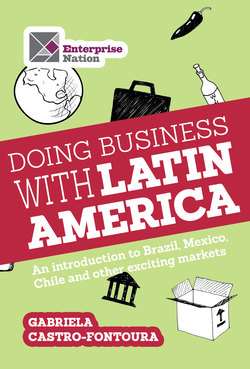Читать книгу Doing business with Latin America - Gabriela Castro-Fontoura - Страница 6
На сайте Литреса книга снята с продажи.
Introduction
ОглавлениеLatin America is a fascinating region. It has some incredibly attractive markets, such as those of Colombia, Chile, Mexico and Brazil, to name but a few. But they are not the only markets in the world.
This book is about Latin America but, particularly if you are fairly new to exporting, it is important from the outset to take a step back and think about international trade as a wider business activity and then focus in on Latin American markets from there.
International trade in general – and particularly exporting – has its risks, whatever markets you are looking at. From managing payment terms and different currencies, through to getting documentation right, logistics, intellectual property concerns, bribery and corruption, and more. In my opinion, all of these risks (with the exception of currencies) are also present when you trade domestically. All small businesses will know about the logistics involved in their own country, such as the risk of your designs being copied, the risks of not being paid or being paid late, etc. When you add to the pot the distance, language differences and cultural barriers, the risks grow.
I will explore these risks in relation to doing business with Latin America, but the risks will clearly exist (in different degrees) no matter what part of the world you focus on. If you are interested in finding out more about international trade I would recommend the book Trade for Good: The Essential Guide to Business and Finance in UK and International Trade by Kevin Shakespeare.
What I personally like to emphasise is that international trade (and all trade) should be about win-win. It is not about patronisingly dumping what we produce on people in poorer countries. It is not about telling people how they should consume or how they should behave. And it is definitely not right to assume that what works in your domestic market will work somewhere else. Sustainable trade is about understanding what the other party wants and providing it. When you start out by thinking “What’s in it for me?” (business is run to make a profit, after all) you also need to think “How can I help?” alongside that. Have you spotted a problem that you can solve? Have you spotted a demand that you can fulfil?
If you design mobile phone applications, you might be saving your customers precious time and money. If you can build a stadium, you will improve their infrastructure and potentially contribute to your export market’s growth. If you craft the most beautiful quintessentially British pottery, you will enhance someone’s home and even their quality of life, at least one tiny bit.
So there are many ways in which you will reach that win-win position that I insist upon. You don’t need to be a public health specialist or a teacher. Doing what you are passionate about, and pursuing the idea that started you in business, can also benefit others across the world. If you think about it that way, you will feel a lot better when you are waiting for that customs clearance or that third connecting flight to get to your South American destination.
